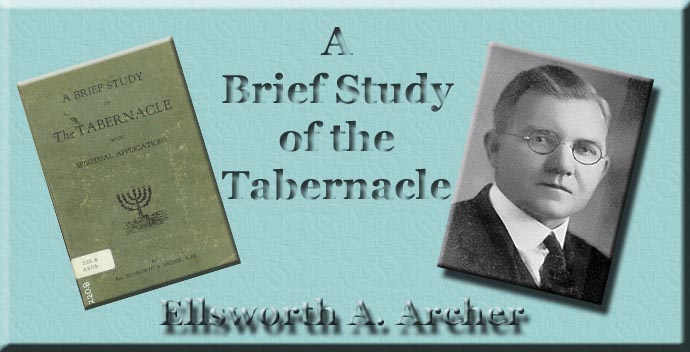
A Brief Study of the Tabernacle
By Ellsworth A. Archer
Chapter 4
THE LAVER.Ex. 30:17-20; 38:8; 40:30-31. The second piece of furniture within the court was the layer, which stood between the altar and the tabernacle. It was made of brass from the mirrors which the women donated. They brought these with them from Egypt. We read that the women secured a great deal of pleasure from these mirrors, and it was, no doubt, a sacrifice for them to give them up, but they were willing to do it for Jehovah. The layer is one of two pieces of furniture in connection with the tabernacle of which we do not know the exact size and shape; but from the different descriptions given, and from the fact that the Bible speaks expressly of the layer and its foot, it was probably circular in form and stood on a foot or base. As this layer was circular in form, having no beginning or end, it symbolizes Christ, our great High Priest, without beginning or end, and it also symbolizes his endless love. The layer, which was kept filled with water, was the place where the priests cleansed themselves before performing the holy function. It was so highly polished that they could see that for which they were looking-"not their beauty, but their blemishes"-then they could wash themselves and be clean. The Bible is our looking glass. The reason so many do not like the Bible is because it presents a true likeness. It is natural to like to be flattered, but God deals faithfully in his word and will show the worst of every case. Do not destroy the Bible if you do not like the picture it shows you of yourself. Smashing a looking glass will not change one's looks, neither will destroying the Bible change human nature, it will be just the same. But as the laver that showed the priests their uncleanness was also the place where they could wash and be made clean, so the Bible will not only show an individual his guilt and sin, but it will also show him the way to be cleansed and redeemed. And, too, this mirror will show Christians their failures and shortcomings. Let us profit by what we see.
These are some lessons which can be learned from the water in the laver. Through the Bible, from Genesis to Revelation, water is mentioned a great deal and is used symbolically. In the second chapter of Genesis we read about the river that went out of Eden to water the garden. In Revelation we read:
We know that water is one of the most important elements in the physical life. About two-thirds, or more, of the human body is water. The brain alone is 90 per cent water. About three-fourths of the earth's surface is water; the fruits and vegetables are composed largely of water, and it is in the air which surrounds us. In fact existence would be impossible without it. The patriarchs valued a good well of water as much, if not more than a good oil well would be valued today, because there were such long spells of drought which occurred periodically in Palestine.
The Laver Notice that in the Bible water is a symbol of cleansing and regeneration. We read in Zechariah of the fountain opened to the house of King David for sin and uncleanness. As water is used for the purpose of cleansing the human body, so the Holy Spirit cleanses from sin.
The laver represented the PLACE of cleansing. The laver itself did not cleanse the priests; it was the water within the' layer. So the Bible does not cleanse a sinner, but the CHRIST of the Bible will cleanse from all sin if he is but given the opportunity. One other point in connection with the laver is, that the water was down low enough so that all could reach it. So the gospel of Jesus Christ is within the reach of all; it is accessible to every one. Whosoever will, let him take the water of life freely." |
|
 |
 |
|
|
|
-
Site Navigation
 Home
Home What's New
What's New Bible
Bible Photos
Photos Hiking
Hiking E-Books
E-Books Genealogy
Genealogy Profile
Free Plug-ins You May Need
Profile
Free Plug-ins You May Need
 Get Java
Get Java.png) Get Flash
Get Flash Get 7-Zip
Get 7-Zip Get Acrobat Reader
Get Acrobat Reader Get TheWORD
Get TheWORD
